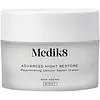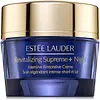What's inside
What's inside
 Key Ingredients
Key Ingredients

 Benefits
Benefits

 Concerns
Concerns

 Ingredients Side-by-side
Ingredients Side-by-side

Water
Skin ConditioningSqualane
EmollientCaprylic/Capric Triglyceride
MaskingDimethicone
EmollientGlycerin
HumectantStearic Acid
CleansingPhytosterols
Skin ConditioningPropylene Glycol
HumectantC12-16 Alcohols
EmollientSodium Acrylate/Sodium Acryloyldimethyl Taurate Copolymer
Emulsion StabilisingCetearyl Alcohol
EmollientPalmitic Acid
EmollientCeramide NP
Skin ConditioningCetearyl Olivate
Linoleic Acid
CleansingBehenyl Alcohol
EmollientHydrogenated Lecithin
EmulsifyingTocopheryl Acetate
AntioxidantSorbitan Olivate
EmulsifyingPhenoxyethanol
PreservativeBenzyl Alcohol
PerfumingAmelanchier Alnifolia Fruit Extract
Skin ConditioningEthylhexylglycerin
Skin ConditioningAcetyl Glucosamine
Skin ConditioningCitric Acid
BufferingSorbitol
HumectantRosmarinus Officinalis Leaf Oil
MaskingCitrus Aurantium Amara Flower Oil
MaskingLavandula Angustifolia Herb Oil
PerfumingCitrus Aurantium Dulcis Peel Oil
MaskingHylocereus Undatus Fruit Extract
Skin ConditioningDehydroacetic Acid
PreservativeTremella Fuciformis Extract
HumectantSodium Lauroyl Lactylate
EmulsifyingAnthemis Nobilis Flower Oil
MaskingPogostemon Cablin Leaf Oil
MaskingVetiveria Zizanoides Root Oil
MaskingAscorbic Acid
AntioxidantDisodium EDTA
Ceramide AP
Skin ConditioningCeteareth-25
CleansingPhytosphingosine
Skin ConditioningCholesterol
EmollientXanthan Gum
EmulsifyingCarbomer
Emulsion StabilisingCetyl Alcohol
EmollientBehenic Acid
CleansingCeramide Ns
Skin ConditioningFerric Hexapeptide-35
Skin ConditioningCeramide EOP
Skin ConditioningCeramide Eos
Skin ConditioningCaprooyl Phytosphingosine
Skin ConditioningCaprooyl Sphingosine
Skin ConditioningAscorbyl Palmitate
AntioxidantTocopherol
AntioxidantGeraniol
PerfumingLimonene
PerfumingLinalool
PerfumingWater, Squalane, Caprylic/Capric Triglyceride, Dimethicone, Glycerin, Stearic Acid, Phytosterols, Propylene Glycol, C12-16 Alcohols, Sodium Acrylate/Sodium Acryloyldimethyl Taurate Copolymer, Cetearyl Alcohol, Palmitic Acid, Ceramide NP, Cetearyl Olivate, Linoleic Acid, Behenyl Alcohol, Hydrogenated Lecithin, Tocopheryl Acetate, Sorbitan Olivate, Phenoxyethanol, Benzyl Alcohol, Amelanchier Alnifolia Fruit Extract, Ethylhexylglycerin, Acetyl Glucosamine, Citric Acid, Sorbitol, Rosmarinus Officinalis Leaf Oil, Citrus Aurantium Amara Flower Oil, Lavandula Angustifolia Herb Oil, Citrus Aurantium Dulcis Peel Oil, Hylocereus Undatus Fruit Extract, Dehydroacetic Acid, Tremella Fuciformis Extract, Sodium Lauroyl Lactylate, Anthemis Nobilis Flower Oil, Pogostemon Cablin Leaf Oil, Vetiveria Zizanoides Root Oil, Ascorbic Acid, Disodium EDTA, Ceramide AP, Ceteareth-25, Phytosphingosine, Cholesterol, Xanthan Gum, Carbomer, Cetyl Alcohol, Behenic Acid, Ceramide Ns, Ferric Hexapeptide-35, Ceramide EOP, Ceramide Eos, Caprooyl Phytosphingosine, Caprooyl Sphingosine, Ascorbyl Palmitate, Tocopherol, Geraniol, Limonene, Linalool
Water
Skin ConditioningGlycine Soja Oil
EmollientCaprylic/Capric/Myristic/Stearic Triglyceride
EmollientGlycerin
HumectantPrunus Amygdalus Dulcis Oil
Skin ConditioningDimethicone
EmollientStearyl Alcohol
EmollientButylene Glycol
HumectantSteareth-2
EmulsifyingCocos Nucifera Oil
MaskingVitis Vinifera Seed Oil
EmollientGlyceryl Stearate
EmollientNiacinamide
SmoothingPropanediol
SolventSteareth-21
CleansingMoringa Oleifera Seed Extract
Skin ConditioningLimonium Vulgare Flower/Leaf/Stem Extract
Skin ConditioningSodium Hyaluronate
HumectantAcetyl Hexapeptide-8
HumectantLaminaria Digitata Extract
Skin ProtectingLactis Proteinum
Skin ConditioningAcetyl Glucosamine
Skin ConditioningTuna Extract
Skin ConditioningTocopheryl Acetate
AntioxidantCitrullus Lanatus Fruit Extract
Skin ConditioningPersea Gratissima Oil
Skin ConditioningMangifera Indica Seed Oil
EmollientAminopropyl Ascorbyl Phosphate
AntioxidantAlgae Extract
EmollientCaffeine
Skin ConditioningCucumis Sativus Fruit Extract
EmollientPyrus Malus Fruit Extract
Skin ConditioningNarcissus Tazetta Bulb Extract
AstringentSigesbeckia Orientalis Extract
Skin ConditioningButyrospermum Parkii Butter
Skin ConditioningLens Esculenta Fruit Extract
Skin ConditioningSilybum Marianum Seed Oil
Skin ConditioningLimnanthes Alba Seed Oil
Skin ConditioningHordeum Vulgare Extract
EmollientSimmondsia Chinensis Seed Oil
EmollientMacadamia Integrifolia Seed Oil
Skin ConditioningOlea Europaea Fruit Oil
MaskingDextrin Palmitate
EmulsifyingSodium Hydroxide
BufferingCarbomer
Emulsion StabilisingBehenyl Alcohol
EmollientCaprylyl Glycol
EmollientHydroxyethyl Urea
HumectantPropylene Glycol Dicaprate
EmollientCholesterol
EmollientIsoceteth-20
EmulsifyingLactoperoxidase
StabilisingHelianthus Annuus Seedcake
AbrasiveSodium Polyaspartate
HumectantSorbitol
HumectantGlucose
HumectantCetyl Alcohol
EmollientMyristyl Alcohol
EmollientSodium Lactate
BufferingCitric Acid
BufferingSodium PCA
HumectantGlucose Oxidase
StabilisingPotassium Phosphate
BufferingSodium Chloride
MaskingParfum
MaskingDisodium EDTA
BHT
AntioxidantPotassium Sorbate
PreservativeSodium Benzoate
MaskingPhenoxyethanol
PreservativeCI 19140
Cosmetic ColorantCI 14700
Cosmetic ColorantCI 77491
Cosmetic ColorantCI 77492
Cosmetic ColorantWater, Glycine Soja Oil, Caprylic/Capric/Myristic/Stearic Triglyceride, Glycerin, Prunus Amygdalus Dulcis Oil, Dimethicone, Stearyl Alcohol, Butylene Glycol, Steareth-2, Cocos Nucifera Oil, Vitis Vinifera Seed Oil, Glyceryl Stearate, Niacinamide, Propanediol, Steareth-21, Moringa Oleifera Seed Extract, Limonium Vulgare Flower/Leaf/Stem Extract, Sodium Hyaluronate, Acetyl Hexapeptide-8, Laminaria Digitata Extract, Lactis Proteinum, Acetyl Glucosamine, Tuna Extract, Tocopheryl Acetate, Citrullus Lanatus Fruit Extract, Persea Gratissima Oil, Mangifera Indica Seed Oil, Aminopropyl Ascorbyl Phosphate, Algae Extract, Caffeine, Cucumis Sativus Fruit Extract, Pyrus Malus Fruit Extract, Narcissus Tazetta Bulb Extract, Sigesbeckia Orientalis Extract, Butyrospermum Parkii Butter, Lens Esculenta Fruit Extract, Silybum Marianum Seed Oil, Limnanthes Alba Seed Oil, Hordeum Vulgare Extract, Simmondsia Chinensis Seed Oil, Macadamia Integrifolia Seed Oil, Olea Europaea Fruit Oil, Dextrin Palmitate, Sodium Hydroxide, Carbomer, Behenyl Alcohol, Caprylyl Glycol, Hydroxyethyl Urea, Propylene Glycol Dicaprate, Cholesterol, Isoceteth-20, Lactoperoxidase, Helianthus Annuus Seedcake, Sodium Polyaspartate, Sorbitol, Glucose, Cetyl Alcohol, Myristyl Alcohol, Sodium Lactate, Citric Acid, Sodium PCA, Glucose Oxidase, Potassium Phosphate, Sodium Chloride, Parfum, Disodium EDTA, BHT, Potassium Sorbate, Sodium Benzoate, Phenoxyethanol, CI 19140, CI 14700, CI 77491, CI 77492
 Reviews
Reviews

Ingredients Explained
These ingredients are found in both products.
Ingredients higher up in an ingredient list are typically present in a larger amount.
Acetyl Glucosamine is an antioxidant and humectant. It is an amino acid sugar and is naturally found in our skin.
The cool thing about this ingredient? It helps the skin produce hyaluronic acid and boost hydration. It also has antioxidant benefits to protect skin cells.
When paired with niacinamide, Acetyl Glucosamine has been shown to be effective at reducing discoloration.
Learn more about Acetyl GlucosamineBehenyl Alcohol is a type of fatty alcohol (these are different from the drying, solvent alcohols).
Fatty Alcohols have hydrating properties and are most often used as an emollient or to thicken a product. They are usually derived from natural fats and oils; behenyl alcohol is derived from the fats of vegetable oils.
Emollients help keep your skin soft and hydrated by creating a film that traps moisture in.
In 2000, Behenyl Alcohol was approved by the US as medicine to reduce the duration of cold sores.
Learn more about Behenyl AlcoholCarbomer is a polymer of acrylic acid. Its main role is to create a gel consistency.
A high amount of carbomer can cause pilling or balling up of products. Don't worry, most products contain 1% or less of carbomer.
Cetyl Alcohol is a fatty alcohol. Fatty Alcohols are most often used as an emollient or to thicken a product.
Its main roles are:
Though it has "alcohol" in the name, it is not related to denatured alcohol or ethyl alcohol.
The FDA allows products labeled "alcohol-free" to have fatty alcohols.
Learn more about Cetyl AlcoholCholesterol is a class of organic molecules called lipids. It helps hydrate your skin and is essential to having a healthy skin barrier.
Our skin naturally contains cholesterol in the outermost layer. Besides cholesterol, it also contains ceramides and fatty acids. Cholesterol makes up about 1/4 of your skin's outer layer and barrier. Your skin barrier is responsible for keeping allergens and microbes out. Having a healthy skin barrier is also responsible for keeping your skin firm and plump.
Our bodies use cholestrol to create vitamin D, steroid hormones, and more.
Learn more about CholesterolCitric Acid is an alpha hydroxy acid (AHA) naturally found in citrus fruits like oranges, lemons, and limes.
Like other AHAs, citric acid can exfoliate skin by breaking down the bonds that hold dead skin cells together. This helps reveal smoother and brighter skin underneath.
However, this exfoliating effect only happens at high concentrations (20%) which can be hard to find in cosmetic products.
Due to this, citric acid is usually included in small amounts as a pH adjuster. This helps keep products slightly more acidic and compatible with skin's natural pH.
In skincare formulas, citric acid can:
While it can provide some skin benefits, research shows lactic acid and glycolic acid are generally more effective and less irritating exfoliants.
Most citric acid used in skincare today is made by fermenting sugars (usually from molasses). This synthetic version is identical to the natural citrus form but easier to stabilize and use in formulations.
Read more about some other popular AHA's here:
Learn more about Citric AcidDimethicone is a type of synthetic silicone created from natural materials such as quartz.
What it does:
Dimethicone comes in different viscosities:
Depending on the viscosity, dimethicone has different properties.
Ingredients lists don't always show which type is used, so we recommend reaching out to the brand if you have questions about the viscosity.
This ingredient is unlikely to cause irritation because it does not get absorbed into skin. However, people with silicone allergies should be careful about using this ingredient.
Note: Dimethicone may contribute to pilling. This is because it is not oil or water soluble, so pilling may occur when layered with products. When mixed with heavy oils in a formula, the outcome is also quite greasy.
Learn more about DimethiconeDisodium EDTA plays a role in making products more stable by aiding other preservatives.
It is a chelating agent, meaning it neutralizes metal ions that may be found in a product.
Disodium EDTA is a salt of edetic acid and is found to be safe in cosmetic ingredients.
Learn more about Disodium EDTAGlycerin is already naturally found in your skin. It helps moisturize and protect your skin.
A study from 2016 found glycerin to be more effective as a humectant than AHAs and hyaluronic acid.
As a humectant, it helps the skin stay hydrated by pulling moisture to your skin. The low molecular weight of glycerin allows it to pull moisture into the deeper layers of your skin.
Hydrated skin improves your skin barrier; Your skin barrier helps protect against irritants and bacteria.
Glycerin has also been found to have antimicrobial and antiviral properties. Due to these properties, glycerin is often used in wound and burn treatments.
In cosmetics, glycerin is usually derived from plants such as soybean or palm. However, it can also be sourced from animals, such as tallow or animal fat.
This ingredient is organic, colorless, odorless, and non-toxic.
Glycerin is the name for this ingredient in American English. British English uses Glycerol/Glycerine.
Learn more about GlycerinPhenoxyethanol is a preservative that has germicide, antimicrobial, and aromatic properties. Studies show that phenoxyethanol can prevent microbial growth. By itself, it has a scent that is similar to that of a rose.
It's often used in formulations along with Caprylyl Glycol to preserve the shelf life of products.
Sorbitol is a sugar alcohol. It is a hydrating and moisturizing agent created from the reduction process of glucose.
Most sorbitol is usually made from potato starch. It is also found in fruits such as apples and pears.
As a humectant, Sorbitol helps draw water to the skin. This helps keep the skin hydrated. Sorbitol also helps create a thicker texture in products. You might find sorbitol in your toothpaste and other gels.
It is a non-irritating ingredient that is great for those with dry skin.
Sorbitol is a prebiotic. It helps promote the growth of healthy bacteria on your skin. The bacteria on your skin form a microbiome. This microbiome helps protect your skin from infection and harmful bacteria.
Learn more about SorbitolTocopheryl Acetate is AKA Vitamin E. It is an antioxidant and protects your skin from free radicals. Free radicals damage the skin by breaking down collagen.
One study found using Tocopheryl Acetate with Vitamin C decreased the number of sunburned cells.
Tocopheryl Acetate is commonly found in both skincare and dietary supplements.
Learn more about Tocopheryl AcetateWater. It's the most common cosmetic ingredient of all. You'll usually see it at the top of ingredient lists, meaning that it makes up the largest part of the product.
So why is it so popular? Water most often acts as a solvent - this means that it helps dissolve other ingredients into the formulation.
You'll also recognize water as that liquid we all need to stay alive. If you see this, drink a glass of water. Stay hydrated!
Learn more about Water